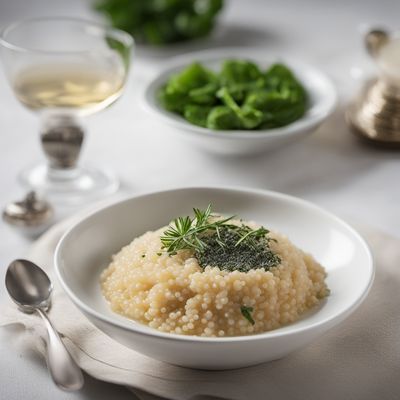
Ingredient
Fish roe
Oceanic Delicacy
Fish roe comes in a variety of sizes, colors, and flavors depending on the fish species. They are typically small, round or oval-shaped, and have a slightly firm yet delicate texture. The taste of fish roe can range from mild and buttery to rich and briny, with a hint of oceanic saltiness. The appearance of fish roe varies greatly, with colors ranging from vibrant red or orange to translucent or black.
Origins and history
The consumption of fish roe dates back centuries and is deeply rooted in various cultures around the world. It has been a staple in many traditional cuisines, particularly in coastal regions where fishing is prevalent. Fish roe is highly regarded for its nutritional value and is often considered a delicacy in many culinary traditions.
Nutritional information
Fish roe is a nutrient-dense ingredient, rich in omega-3 fatty acids, protein, vitamins, and minerals. It is also relatively low in calories, making it a healthy addition to meals. However, the nutritional content may vary depending on the fish species and preparation method.
Allergens
Fish roe may cause allergic reactions in individuals with seafood allergies. It is important to exercise caution and consult with a healthcare professional if you have any known allergies or sensitivities.
How to select
When selecting fish roe, opt for fresh roe that has a firm texture and a vibrant color. Avoid roe that appears dull, discolored, or has a strong fishy odor. If purchasing from a fish market or seafood counter, ask the fishmonger for recommendations on the best-quality roe available.
Storage recommendations
To maintain the freshness and quality of fish roe, it is crucial to store it properly. Keep the roe refrigerated at temperatures below 40°F (4°C) in an airtight container or wrapped tightly in plastic wrap. Consume fish roe within a few days of purchase for the best flavor and texture.
How to produce
Fish roe is typically produced by harvesting the eggs from mature female fish. The process involves carefully extracting the roe sacs and separating them from any connective tissues. Fish roe can be obtained from various fish species, including salmon, trout, sturgeon, and herring. However, due to the complexity and specialized equipment required, it is best left to professional fish processors or experienced individuals.
Preparation tips
Fish roe can be enjoyed in a variety of ways, including raw, marinated, or cooked. It is commonly used as a topping or garnish for sushi, sashimi, and seafood dishes. Fish roe can also be incorporated into spreads, dips, or sauces to add a burst of flavor. Additionally, it can be used to enhance the taste and presentation of salads, pasta dishes, or omelets.
Culinary uses
Fish roe is widely used in various cuisines around the world, including Japanese, Russian, Scandinavian, and Mediterranean. It is commonly found in dishes such as caviar, sushi, taramasalata, and bottarga. The unique texture and flavor of fish roe make it a sought-after ingredient in gourmet cooking.
Availability
Fish roe is commonly available in coastal regions and areas with access to fresh seafood. It can be found in fish markets, specialty seafood stores, and some supermarkets. The availability may vary depending on the fish species and local fishing seasons.
More ingredients from this category » Browse all

Herring roe
"Oceanic Delicacy: Exploring the World of Herring Roe"

Mullet roe
The Delicacy of the Sea

Bluefish roe
Oceanic Delicacy: Exploring Bluefish Roe

Flounder roe
The Ocean's Golden Treasure: Exploring the Delicacy of Flounder Roe

Cod roe
"The Ocean's Delicacy: Exploring the Richness of Cod Roe"

Salmon roe, atlantic
"Oceanic Delicacy: Exploring the World of Atlantic Salmon Roe"

Salmon roe, pacific
Oceanic Delicacy

Mackerel roe
The Ocean's Golden Treasure: Exploring the Delicacy of Mackerel Roe

Shad roe
Delicate Delicacy

Sturgeon roe
The Jewel of the Sea

Lumpfish roe
The Jewel of the Sea

Dolphinfish roe
Oceanic Delicacy: Dolphinfish Roe
Recipes using Fish roe » Browse all

Molecular Gastronomy Satay
Satay Reimagined: A Molecular Gastronomy Delight

Southeast Asian-inspired Fish Roe Salad
Oceanic Delight: Southeast Asian Fish Roe Salad

Haute Cuisine Tapas
Elevated Spanish Small Plates

Molecular Papricaș de Pește
The Molecular Transformation of Papricaș de Pește: A Fusion of Hungarian Tradition and Molecular Gastronomy

Haute Cuisine Nasi Goreng
Elevated Indonesian Fried Rice

Haute Khanum Budu
Elevated Delicacy: Haute Khanum Budu

Russian Caviar Canapés
Elegant Delights: Russian Caviar Canapés

Haute Omelette
Elevate Your Brunch: Haute Omelette with a Gourmet Twist

Caviar Risotto
Luxurious Caviar Risotto: A Decadent Delight from Italy

Haute Cuisine Fish and Brewis
Elevated Fish and Brewis: A Haute Cuisine Delight

Haute Cuisine Ceviche
Elevated Peruvian Delight: Haute Cuisine Ceviche

Caviadini della Valsassina
Savory Delights from the Italian Alps